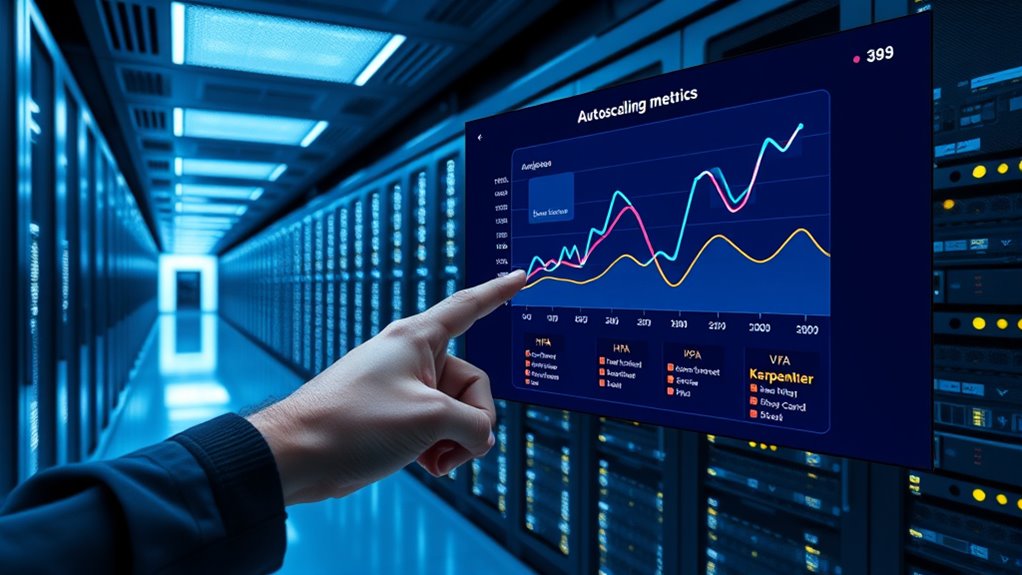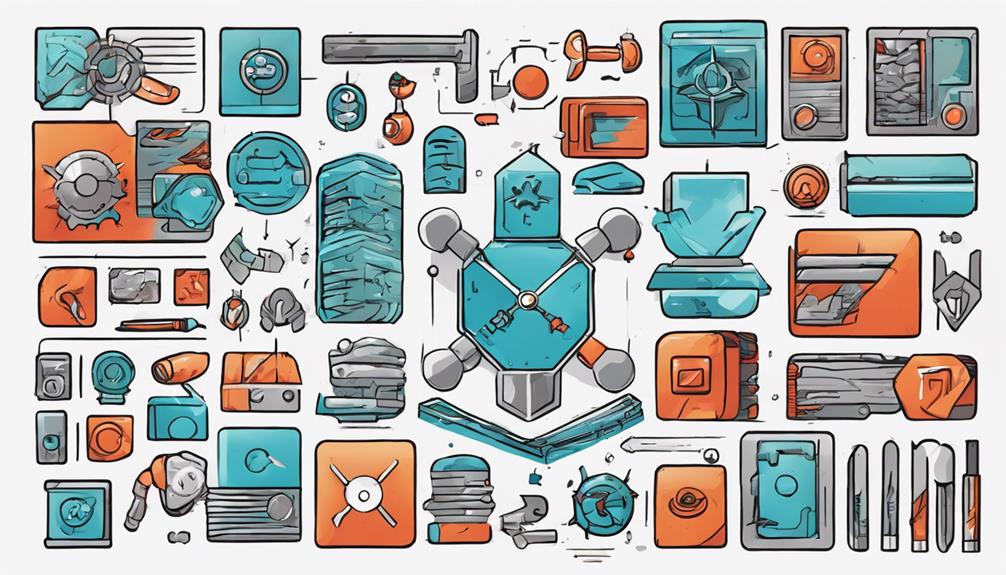Choosing the most cost-efficient autoscaling method depends on your workload’s needs. HPA is great for quick, scalable responses by adjusting pod counts, while VPA optimizes resource allocation within individual pods, which can reduce costs over time. Karpenter dynamically provision and deprovision nodes, making it ideal for highly variable workloads and cost savings at the cluster level. To find the best fit for your needs, explore the key strengths of each option.
Key Takeaways
- Karpenter typically offers better cost efficiency for highly variable workloads by dynamically provisioning and deprovisioning nodes.
- VPA can reduce costs by optimizing resource requests per pod but may cause downtime during resizing.
- HPA maximizes resource utilization and offers rapid scaling, which can prevent over-provisioning and reduce costs.
- Choosing between tools depends on workload predictability: VPA for stable resource needs, HPA for rapid scaling, Karpenter for workload variability.
- Combining autoscalers (e.g., HPA with Karpenter) can further enhance cost savings through optimized cluster and pod scaling.

Have you ever wondered how to handle fluctuating workloads without overspending? Managing resources efficiently is vital if you want to keep costs down while maintaining performance. This is where resource optimization and effective scaling strategies come into play. Autoscaling tools like Horizontal Pod Autoscaler (HPA), Vertical Pod Autoscaler (VPA), and Karpenter each offer unique approaches to handling dynamic workloads, but choosing the right one depends on your specific needs and goals.
HPA is a popular choice for scaling out your applications horizontally. It automatically increases or decreases the number of pods based on real-time metrics like CPU utilization or custom metrics. This approach is excellent for workloads with unpredictable traffic patterns because it helps you maximize resource utilization without over-allocating. By adjusting the number of pods, you can respond swiftly to demand spikes, ensuring your application remains responsive without paying for idle resources during off-peak times. HPA excels at resource optimization by scaling only what’s necessary, but it works best when your workload can be distributed across multiple pods.
VPA, on the other hand, focuses on vertical scaling—adjusting the resource limits and requests of individual pods. When your application’s resource needs change over time, VPA can resize pods accordingly, providing a more tailored fit for your workload. This method is particularly useful if you run stateful applications or services that don’t benefit from horizontal scaling. With VPA, you avoid the complexity of managing many pods and instead optimize the resources within each pod, reducing overhead and potentially lowering costs. However, VPA can introduce some downtime during resizing and may not be ideal for workloads requiring rapid scaling or high availability.
Karpenter approaches autoscaling with a different philosophy, emphasizing intelligent, cluster-level resource provisioning. It dynamically provisions and deprovisions nodes based on workload demands, offering a more flexible and granular scaling strategy. Karpenter can quickly adapt to changing workloads by launching new nodes only when necessary, and it can select the most appropriate instance types, optimizing both performance and costs. This makes it especially suitable for environments with highly variable workloads or those running on cloud platforms where cost efficiency hinges on choosing the right instance types. Karpenter’s ability to optimize resource allocation at the cluster level enhances resource utilization and can markedly reduce expenses compared to traditional autoscaling methods. Additionally, understanding the role of natural materials like wood and linen helps in designing environments that are both functional and authentic, similar to how Karpenter optimizes for the best possible resource fit.
Frequently Asked Questions
How Do HPA, VPA, and Karpenter Compare in Real-World Costs?
You’re wondering how HPA, VPA, and Karpenter compare in real-world costs. These autoscaling tools help with resource allocation, each offering unique benefits. HPA adjusts based on CPU and memory, VPA optimizes resource requests, and Karpenter dynamically provisions nodes. For cost optimization, Karpenter often provides the best results by reducing over-provisioning. Your choice depends on workload demands and balancing cost efficiency with performance.
Can These Autoscaling Methods Be Combined for Better Efficiency?
Ever wondered if combining autoscaling methods could boost your resource optimization? Yes, you can integrate HPA, VPA, and Karpenter for better scalability strategies. Using them together allows you to respond dynamically to workload changes, optimizing costs and performance. HPA adjusts based on load, VPA fine-tunes resource requests, and Karpenter manages node provisioning. This synergy helps you achieve more efficient, flexible autoscaling tailored to your specific needs.
What Are the Setup Complexities for Each Autoscaling Option?
When setting up autoscaling options, you should consider deployment strategies and security considerations. HPA is straightforward, adjusting based on CPU or memory, but may require careful security setup for data collection. VPA is more complex, optimizing resource requests but needing careful deployment planning to avoid disruptions. Karpenter offers flexible provisioning, but its setup involves detailed cluster configuration. Prioritize security to protect autoscaling controls and ensure your deployment strategy aligns with your scaling needs.
Which Autoscaler Offers the Fastest Response Time?
You want the autoscaler with the fastest response time and scaling speed. Karpenter typically responds quicker because it dynamically provisions resources based on real-time demand, reducing delays. HPA and VPA adjust existing resources, which can be slightly slower. If quick scaling is your priority, Karpenter’s proactive approach makes it the best choice for rapid response time and faster scaling speed.
How Do Autoscaling Costs Impact Overall Cloud Budget Management?
Like a tightrope walker balancing, autoscaling costs influence your cloud budget management. When you consider cost prediction and resource optimization, you realize that overspending can be as risky as under-provisioning. Efficient autoscaling minimizes unnecessary expenses, ensuring resources match demand. By carefully monitoring and adjusting, you keep your budget in check while maintaining performance, turning cloud costs from a threat into a strategic advantage.
Conclusion
Think of autoscaling as the lighthouse guiding your cloud costs through foggy waters. Whether you choose HPA, VPA, or Karpenter, remember that each offers a different beam of light. By understanding their strengths and aligning them with your needs, you illuminate a path to efficiency. When you harness the right tool, your costs become a steady beacon—guiding your infrastructure safely home, saving resources, and shining brightly in your cloud journey.









